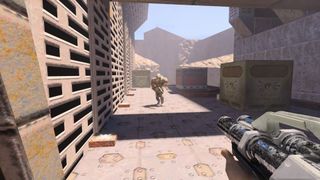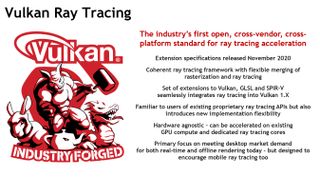Vulkan Ray Tracing support enables even AMD GPUs to run Quake II RTX
And Nvidia helped make it happen.

It's more good news from the Vulkan API camp: The open consortium responsible for the popular game API has announced full support for Vulkan Ray Tracing has arrived in its SDK, tools, and across the latest AMD and Nvidia drivers, thus enabling waves of developers to jump on the ray tracing wagon cross-platform. There's even a Vulkan Ray Tracing game ready to go out of the gate: Quake II RTX.
Quake II RTX was Nvidia's ray-traced baby at launch, a free overhaul of the popular shooter rendered using a full path tracer, an all encompassing ray tracing solution—powered by Nvidia's VK_NV_ray_tracing Vulkan extension. This own-brand extension would later fold into the official Vulkan Ray Tracing extension, launched last month and today receiving full support, and that means Quake II RTX will now work on any Vulkan Ray Tracing compatible GPU—yep, even AMD's.
Quake II RTX also comes with a built-in benchmark to compare compatible GPU performance. That's currently only of real interest to gamers in testing Nvidia's Ampere GPUs to AMD's RDNA 2 GPUs, both of which contain ray tracing acceleration and today receive full driver support for Vulkan Ray Tracing. However, Intel Xe-HPG GPUs, Intel's upcoming gaming chips, will also be compatible at launch, sometime in 2021.
Nvidia, AMD, and Intel all rank among the over 150 companies that make up and contribute to the Khronos Group consortium.
The Vulkan Ray Tracing extension receiving full support has greater implications for the games and 3D industry, however. Cross-platform ray tracing from Vulkan means developers won't need to rely on Microsoft's DirectX Raytracing API, which has been happily running most ray-traced games to-date, or have to create an entire solution in-house, as we saw with Crytek's CryEngine.
"Shipping API specifications was just the first step in building the developer ecosystem for Vulkan Ray Tracing, we now have tools and samples to truly enable developers to tap into the power of cross-platform ray tracing acceleration," Daniel Koch, senior graphics system software engineer at Nvidia and Vulkan Ray Tracing TSG chair at Khronos, says. "One of the key requests from the developer community was the ability to easily bring DirectX 12 ray tracing (DXR) code to Vulkan. We have achieved that through delivering a carefully designed superset of DXR, and integrating Vulkan Ray Tracing support in the DXC open source HLSL compiler."

The Vulkan Ray Tracing extension is reportedly similar to that which is used with other proprietary solutions today, and it should be a simple enough process to port code between Vulkan and DX12, too. Part of that is thanks to the reuse of HLSL code, or High Level Shading Language, which is used with DirectX and was made possible to port right into Vulkan earlier this year thanks to Nvidia's developers.
The biggest gaming news, reviews and hardware deals
Keep up to date with the most important stories and the best deals, as picked by the PC Gamer team.

Best gaming mouse: the top rodents for gaming
Best gaming keyboard: your PC's best friend...
Best gaming headset: don't ignore in-game audio
One of few modern Vulkan ray-traced games so far, Wolfenstein: Youngblood, utilises the initial Nvidia-built Vulkan Ray Tracing extension. As such, it's currently limited to Nvidia's RTX cards only, yet the introduction of the Vulkan Ray Tracing extensions could make further AMD card support possible if implemented.
It will still be some time until we see shipping products built using the Vulkan Ray Tracing extensions fully even so, but it's in the hands of developers to put to good use now and that's great news for cross-platform ray tracing support.
And so the ray tracing ecosystem gets that little bit more complete. We certainly now have all the components for wide adoption of ray tracing headed into 2021, from hardware to software to communicate to it, and that's great news if you, like me, love cranking every ray-traced effect up to 11 and diving into photo mode.

Jacob earned his first byline writing for his own tech blog. From there, he graduated to professionally breaking things as hardware writer at PCGamesN, and would go on to run the team as hardware editor. He joined PC Gamer's top staff as senior hardware editor before becoming managing editor of the hardware team, and you'll now find him reporting on the latest developments in the technology and gaming industries and testing the newest PC components.
Most Popular






